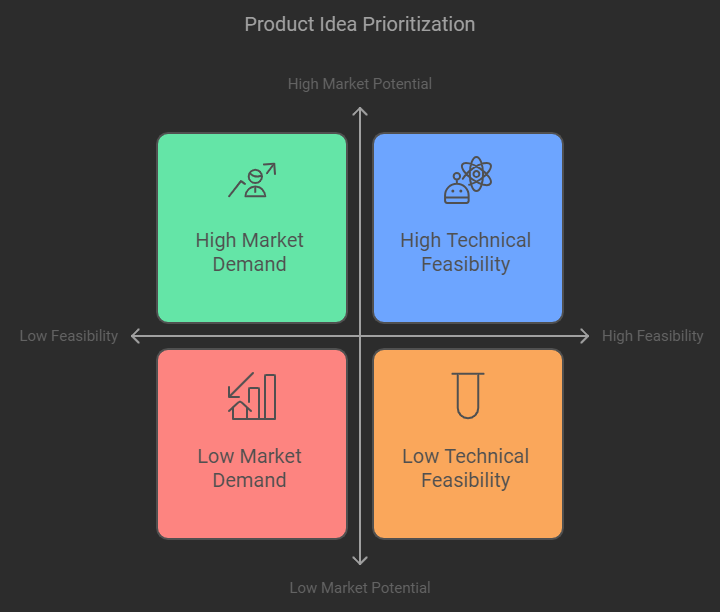The Process of Screening Your Ideas
Have you ever had a great idea but weren’t sure what to do next?
Screening your ideas can help you decide which ones have the most potential.
By examining your ideas from different angles and gathering feedback, you can determine which ones are worth pursuing and which ones may need more work.
In this article, we’ll explore the steps in screening your ideas and how this process can ultimately lead to success.
What Does Picking Ideas Mean?
Picking ideas involves filtering and selecting promising product concepts. Factors like market demand, customer needs, technical feasibility, and available resources are considered.
To determine an idea is good, evaluate it against set criteria and conduct in-depth research. Methods such as SWOT analysis and PESTEL analysis can be used effectively.
The blog introduces the BRIDGeS framework for idea screening, which involves analyzing the benefits, risks, issues, domain knowledge, goals, and solutions of a potential product. This framework provides a structured approach to picking ideas.
Steps to Find Great Ideas

Gather Lots of Ideas
Effective methods for gathering many ideas exist. These can include brainstorming sessions, surveys, market research, and seeking inspiration from various sources such as customer feedback, industry trends, and competitor analysis.
Individuals can involve diverse stakeholders, encourage open communication, and actively seek out unconventional, out-of-the-box concepts to consider a wide variety of ideas.
Determining if enough diverse ideas have been gathered to make an informed decision can be achieved through qualitative and quantitative analysis, benchmarking against industry standards, and seeking feedback from diverse experts, including customers, engineers, marketers, and financial analysts.
These various methods help to ensure that a broad spectrum of ideas is thoroughly evaluated, providing a solid foundation for selecting the most viable product concepts for development.
First Look at Your Ideas
When you have new ideas for a product, it’s important to evaluate them early on. This means looking at market demand, customer needs, technical possibilities, and available resources. Doing this helps startups determine which product ideas are likely to succeed.
For example, idea screening helps prioritize the best product concepts and puts resources into the right products by eliminating less promising ideas. It also prevents wasting time and resources on products that don’t meet market demand or customer needs. Instead, it ensures that startups work on products with a good chance of success by carefully evaluating ideas against set criteria.
Some ways to do this evaluation include using tools like SWOT and PESTEL analyses. These are helpful for examining ideas and strategies.
Make Your Idea Better
Idea screening is about choosing the best product concepts based on factors like market demand, customer needs, technical feasibility, and resources. To avoid failure, it’s important to focus on the right product from the start. Startups should evaluate ideas against criteria and do thorough research.
The BRIDGeS framework for idea screening involves analyzing benefits, risks, issues, domain knowledge, goals, and solutions. SWOT analysis and PESTEL analysis are useful tools for examining ideas and strategies.
By rigorously screening and evaluating ideas, startups can develop successful products.
Check If Your Idea Can Make Money
To see if an idea can make money, it’s important to examine its revenue potential. This means checking whether people want it, are willing to pay for it, and can grow. It’s also important to see what similar products are available and how this idea can stand out and gain a share of the market.
Doing market research and predicting finances is key. It helps to know the market size, how it’s growing, and how to price things right. It’s also about figuring out how much it’ll cost and how much money can be made.
It is also crucial to find any obstacles to making money, like rules, tech limits, or competition. Knowing these challenges helps to plan and make the idea as profitable as possible.
Try Out Your Idea
Effective ways to try out a new idea:
- Evaluate market demand, customer needs, technical feasibility, and available resources.
- Conduct thorough research and analysis to determine if the idea is viable.
- Consider potential challenges such as competition, changing consumer preferences, and resource limitations.
- Use tools like SWOT analysis and PESTEL analysis to examine potential challenges and strategies.
Pick the Ideas That Work Best
Idea screening helps startups choose the best product ideas. It considers market demand, customer needs, technical feasibility, and available resources. This is important for startups to avoid failure and focus on building the right product. Idea screening also emphasizes evaluating ideas against set criteria and conducting thorough research.
The BRIDGeS framework analyzes a potential product’s benefits, risks, issues, domain knowledge, goals, and solutions. It also mentions idea screening examples like SWOT and PESTEL analysis as effective tools for examining ideas and strategies.
The main focus is to ensure that startups develop products with a high chance of success by rigorously screening and evaluating ideas.
How to Know if an Idea is Good

Make Sure Your Idea Matches Your Goals
When you’re considering an idea, it’s important to think about specific goals like market demand, customer needs, technical feasibility, and available resources. These factors help determine if your product concept can succeed. It’s also important to align your idea with long-term objectives and vision by researching and analyzing how it fits the startup’s mission, values, and overall business objectives.
This ensures the new product contributes to the organization’s long-term growth and success.
Find Out More About Your Idea
Idea screening involves several steps to determine a product concept’s potential. These include evaluating market demand, customer needs, technical feasibility, and available resources. Entrepreneurs and startups can ensure that their ideas align with set criteria and goals by conducting research and analysis. Techniques such as the BRIDGeS framework for idea screening, SWOT analysis, and PESTEL analysis offer effective ways to evaluate and select promising ideas systematically.
By using these tools, businesses can develop a systematic approach to identifying feasible and potentially successful product concepts.
Using a List to Help Choose Ideas

Good and Bad About Your Idea (SWOT)
When evaluating an idea for product development, it is important to consider its strengths and weaknesses. For instance, a strength could be meeting unmet customer needs, while a weakness might be the lack of a viable distribution channel.
It’s also important to consider the opportunities and threats the idea might face in the market. An opportunity could be entering an untapped market segment, while a threat could involve competing with well-established brands.
Startups can improve their ideas by incorporating customer feedback, but potential risks exist, such as technical challenges or market demand changes. Thorough analysis and evaluation of these aspects are necessary to ensure the selected ideas have a high chance of success.
Looking at the Big Picture (PESTEL)
The external environment influences idea selection and success. Factors like politics, economics, society, tech, environment, and law play a role. Government policy changes can create new opportunities or threats. Economic and societal trends affect new product demand. Understanding PESTEL factors is crucial for evaluating the long-term implications of ideas. Tech advancements offer innovation opportunities but also adoption risks.
Analyzing PESTEL helps make informed decisions about which ideas to pursue. It provides insights into market barriers, competition, and trends. Considering these factors helps startups align their ideas with the macro-environment, increasing their market success.
Having a System for Picking Ideas
When developing a system for picking ideas, consider factors such as:
- Market demand
- Customer needs
- Technical feasibility
- Available resources
These factors ensure that the selected product concepts are highly likely to succeed and are aligned with the startup’s goals and vision.
Individuals can use frameworks such as BRIDGeS to ensure alignment with a startup’s goals and objectives. This helps evaluate the benefits, risks, domain knowledge, and solutions of a potential product, ensuring alignment with the company’s overall mission and objectives.
Effective methods like SWOT and PESTEL analysis can evaluate and prioritize potential ideas. These tools provide a comprehensive understanding of the strengths, weaknesses, opportunities, and threats associated with each idea. This facilitates informed decision-making and helps identify the most promising product concepts for further development.
What to Do After Finding an Idea

After finding an idea, the next steps involve evaluating its potential and deciding whether to pursue it.
Criteria such as market demand, technical feasibility, and available resources should be considered when deciding which idea to pursue.
For example, startups can conduct a SWOT analysis to examine the strengths, weaknesses, opportunities, and threats associated with their ideas.
They can also use PESTEL analysis to consider political, economic, social, technological, environmental, and legal factors.
The BRIDGeS framework, which analyzes a potential product’s benefits, risks, issues, domain knowledge, goals, and solutions, can also be helpful for idea screening.
By thoroughly evaluating ideas based on these criteria and frameworks, startups can ensure that they focus their efforts and resources on building the right product from the beginning, thereby increasing the probability of success.

Vizologi is a revolutionary AI-generated business strategy tool that offers its users access to advanced features to create and refine start-up ideas quickly.
It generates limitless business ideas, gains insights on markets and competitors, and automates business plan creation.


